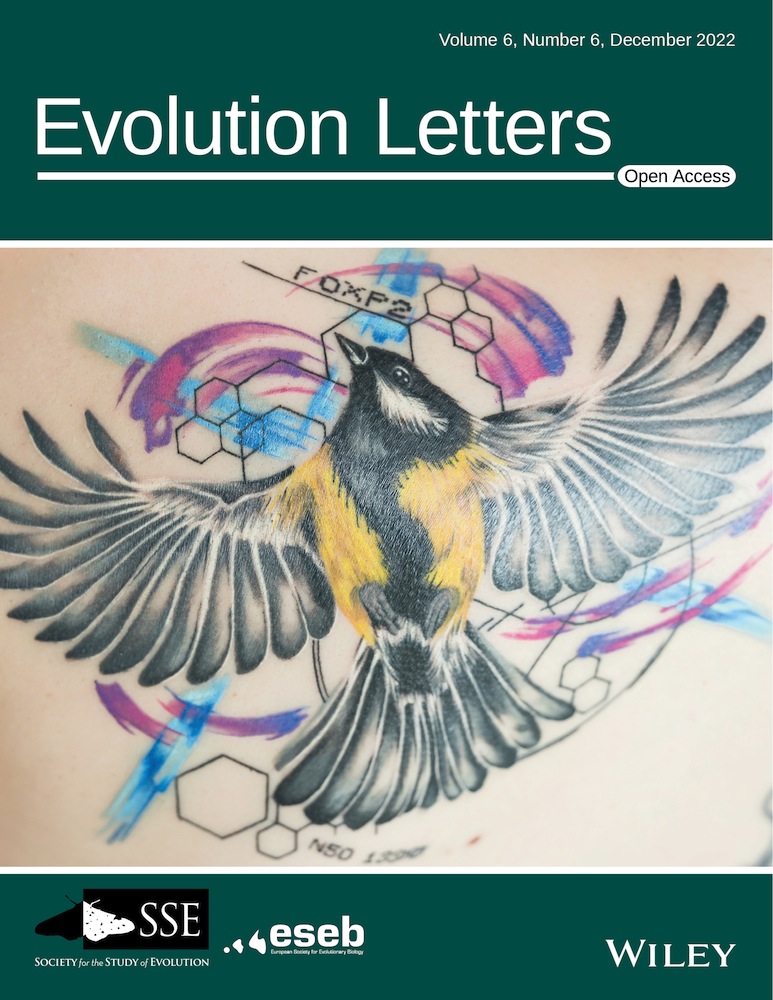在植物致病菌中,噬菌体选择驱动抗性-毒力权衡,而与生长温度无关
IF 3.7
1区 生物学
Q2 EVOLUTIONARY BIOLOGY
引用次数: 0
摘要
虽然温度已被证明会影响细菌及其噬菌体寄生虫的生存和生长,但目前尚不清楚噬菌体耐药性和其他细菌特性之间的权衡是否取决于温度。在这里,我们实验比较了25°C和35°C温度环境下植物致病性稻瘟病菌(Ralstonia solanacearum)噬菌体耐药性-毒力权衡的进化和潜在的分子机制。我们发现,虽然噬菌体在25°C时相对更能降低番茄红霉的密度,但不同温度处理对噬菌体的最终抗性水平没有差异。相反,在两种温度处理下,生长速度增加的小菌落变异(scv)和群体感应(QS)信号受体基因(phcS)突变都在进化。有趣的是,scv也具有噬菌体抗性,并且在噬菌体存在时达到更高的频率。进化噬菌体抗性是昂贵的,导致植物携带能力、生物膜形成和毒力降低,可能是由于失去了qs介导的关键毒力基因的表达。我们还观察到黏液噬菌体抗性菌落表现出毒力丧失和痉挛运动性降低,这可能是由于prepilin肽酶基因pilD的平行突变。此外,35°c噬菌体处理的抗噬菌体scv在II型分泌系统(T2SS)基因(gspE和gspF)中存在平行突变。吸附实验证实了pilD作为噬菌体受体的作用,而phcS或T2SS突变体没有发现吸附损失,表明其他下游噬菌体耐药机制。另外的转录组学分析显示,在噬菌体暴露后,CBASS和I型限制性修饰噬菌体防御系统的表达上调,这与运动性和毒力相关基因(包括pilD和II型和III型分泌系统)的表达减少相一致。总之,这些结果表明,虽然噬菌体耐药性-毒力的权衡不受生长温度的影响,但它们可以通过感染前和感染后噬菌体抗性机制介导。本文章由计算机程序翻译,如有差异,请以英文原文为准。
Phage selection drives resistance–virulence trade-offs in Ralstonia solanacearum plant-pathogenic bacterium irrespective of the growth temperature
Abstract While temperature has been shown to affect the survival and growth of bacteria and their phage parasites, it is unclear if trade-offs between phage resistance and other bacterial traits depend on the temperature. Here, we experimentally compared the evolution of phage resistance–virulence trade-offs and underlying molecular mechanisms in phytopathogenic Ralstonia solanacearum bacterium at 25 °C and 35 °C temperature environments. We found that while phages reduced R. solanacearum densities relatively more at 25 °C, no difference in the final level of phage resistance was observed between temperature treatments. Instead, small colony variants (SCVs) with increased growth rate and mutations in the quorum-sensing (QS) signaling receptor gene, phcS, evolved in both temperature treatments. Interestingly, SCVs were also phage-resistant and reached higher frequencies in the presence of phages. Evolving phage resistance was costly, resulting in reduced carrying capacity, biofilm formation, and virulence in planta, possibly due to loss of QS-mediated expression of key virulence genes. We also observed mucoid phage-resistant colonies that showed loss of virulence and reduced twitching motility likely due to parallel mutations in prepilin peptidase gene, pilD. Moreover, phage-resistant SCVs from 35 °C-phage treatment had parallel mutations in type II secretion system (T2SS) genes (gspE and gspF). Adsorption assays confirmed the role of pilD as a phage receptor, while no loss of adsorption was found with phcS or T2SS mutants, indicative of other downstream phage resistance mechanisms. Additional transcriptomic analysis revealed upregulation of CBASS and type I restriction-modification phage defense systems in response to phage exposure, which coincided with reduced expression of motility and virulence-associated genes, including pilD and type II and III secretion systems. Together, these results suggest that while phage resistance–virulence trade-offs are not affected by the growth temperature, they could be mediated through both pre- and postinfection phage resistance mechanisms.
求助全文
通过发布文献求助,成功后即可免费获取论文全文。
去求助
来源期刊

Evolution Letters
EVOLUTIONARY BIOLOGY-
CiteScore
13.00
自引率
2.00%
发文量
35
审稿时长
10 weeks
期刊介绍:
Evolution Letters publishes cutting-edge new research in all areas of Evolutionary Biology.
Available exclusively online, and entirely open access, Evolution Letters consists of Letters - original pieces of research which form the bulk of papers - and Comments and Opinion - a forum for highlighting timely new research ideas for the evolutionary community.
 求助内容:
求助内容: 应助结果提醒方式:
应助结果提醒方式:


